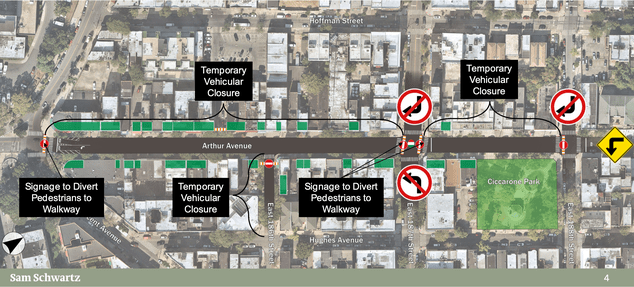Indoor dining isn't the only thing that's paused.
The de Blasio administration announced on Wednesday that the city would not begin indoor dining as expected on Monday — yet it refused to share details of how (or if) the city would expand an already announced limited open restaurants plan that is set to launch on Friday with just 10 to 20 street segments and last only until Labor Day.
"Stay tuned," was all a City Hall spokesman would say when pressed by Streetsblog to reveal whether the mayor would, indeed, "double down on outdoor dining," as he said on Wednesday.
Citing the 6,700 restaurants that are part of an existing initiative that allows eateries to use sidewalk space and curbside spaces (if they happened to be unoccupied), the mayor said his administration is in the midst of "a huge outreach effort [that's] been going on for days ... to show restaurants that qualify that they can take advantage of this right away."
But he did not give more details, leaving city restaurateurs in the lurch, not knowing if the city would create more outdoor space quickly beyond the 10 to 20 street segments.
"The open restaurants program is a runaway hit, but if restaurants and bars are to safely meet the demand for al fresco dining in New York City, the program needs to grow," said Henry Rinehart, a restaurant industry consultant who has been advocating for a massive increase in open space for eateries.

"Our mayor must immediately extend the sunset date for open restaurants to Oct. 31, and get more safety barriers in place on our streets to prevent more traffic violence as our streets come back to life."
Andrew Rigie of the NYC Hospitality Alliance added that restaurant owners "respect the government and public health officials’ decision to postpone ... indoor dining, but the longer neighborhood restaurants and bars are forced to be closed, the harder it will be for them to ever successfully reopen."
Manhattan restaurateurs are taking the most advantage of the city's existing initiatives, with almost exactly half of the restaurants currently participating located on the city's main island. Brooklyn, the city's most populous borough, has about 1,300 participating restaurants, despite a population of one million more than Manhattan.
Manhattan eateries got a big boost this week, as the city opened up 389 privately owned public spaces — often plazas on private property — to dining, waiving zoning rules that have barred commercialization of the spaces.
All but 26 — or less than 7 percent — are in Manhattan (map here).
Some restaurateurs complained that the city's assistance doesn't go far enough to help mom and pop joints that simply don't have deep pockets or the wherewithal to suddenly go deep in the outdoor dining game.
"We're no longer restaurateurs — we're street hustlers," said Roni Mazumdar, who owns Adda, the impeccable Indian restaurant on a busy street in Long Island City. "You tell me how a small restaurant is to quickly find six umbrellas, find a car, get them to the location, build ADA-accessible ramps, etc. Yes, the city's application process was streamlined, but there's a disconnect between the strategy and reality. I'm running to six different Home Depots to get stuff!"

Worse, Adda is located on Thomson Avenue, which is too busy a street to allow curbside dining. "Plus, the lighting is terrible, so suddenly I'd have to get lighting, too," Mazumdar added. "No one rents a location thinking that one day, his restaurant is only going to be on the sidewalk. And renting barricades is expensive."
He hopes the city will announce some kind of subsidized equipment rental, such as tents and umbrellas to supplement an existing "marketplace" website that is heavy on print shops and light on equipment, but he isn't holding his breath, given the terrible budget situation in which the city finds itself.
"I'm just saying, it sounds simple on paper — get some umbrellas," he said. "Sure, you do it."






